 Overview of CIA Water-Air Division equipment, 1958
Overview of CIA Water-Air Division equipment, 1958
 This is a selected summary and analysis of ”Equipment and/or Test Reports Available for Operational use or Planning” from a 1958 CIA booklet (now declassified with redaction). It was compiled by the CIA Water-Air Division who were the Cold War evolution of the Wartime OSS Maritime Unit. The original can be found HERE
This is a selected summary and analysis of ”Equipment and/or Test Reports Available for Operational use or Planning” from a 1958 CIA booklet (now declassified with redaction). It was compiled by the CIA Water-Air Division who were the Cold War evolution of the Wartime OSS Maritime Unit. The original can be found HERE
Swimmer Delivery Vehicles
The only enclosed Swimmer Delivery Vehicle (SDV, at the time called Swimmer Propulsion Units) listed is the American designed Aerojet Mk.VI. This was a peddle contraption which although offering some promise during tests by the US Navy’s Underwater Demolition Teams (UDT) was found to be impractical operationally due to the effort involved in propelling it. The CIA did not recommend it.
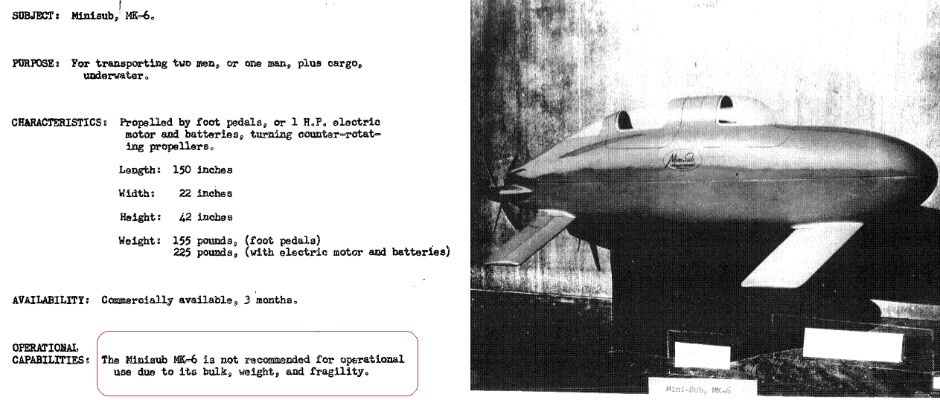
About the same time as this booklet UDT was beginning to import electric powered SPUs from Italy (Cos.Mo.S Seahorse-II) and experiment with their own one and two man designs, also by Aerojet. It would not be until the 1970s that truly practical SDVs would be available.
The Aquaped was another Aerojet contraption using peddle power. Again the CIA did not recommend it.
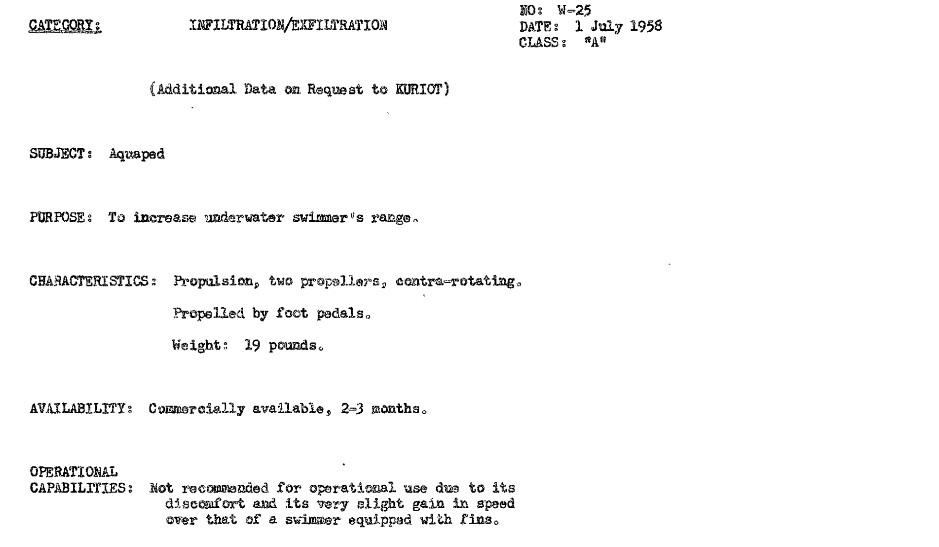
The CIA booklet did not include a photo of the Aquaped so here is one provided by the Canadian Naval Divers Association (CNDA):
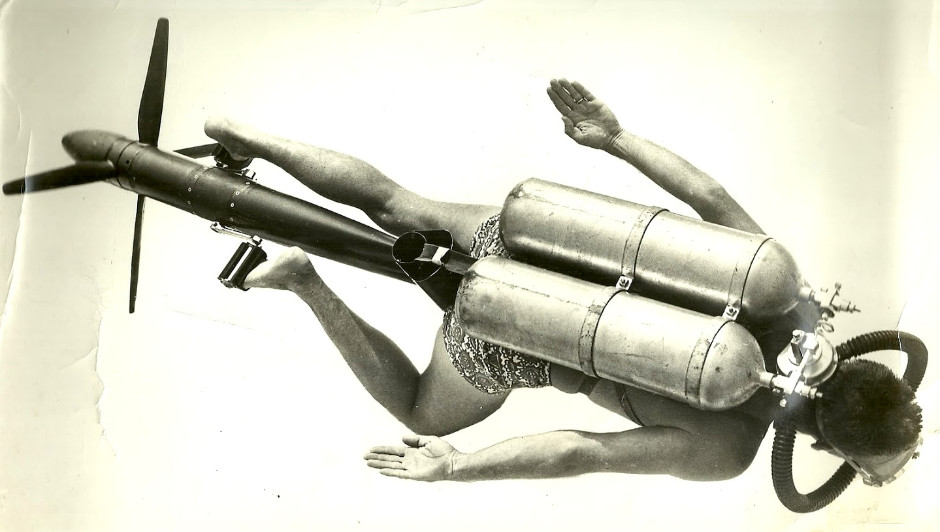
The ultimate book of Special Forces subs Covert Shores 2nd Edition is the ONLY world history of naval Special Forces, their missions and their specialist vehicles. SEALs, SBS, COMSUBIN, Sh-13, Spetsnaz, Kampfschwimmers, Commando Hubert, 4RR and many more.
Check it out on Amazon
Military canoes
Neptune inflatable kayak. Civilian type purchased from overseas producer. Yet to identify actual brand/producer. Due to their shape and seaworthiness Kayaks had some advantages over inflatable boats for 1-3 man transport, particularly if outboard motors were not available or not appropriate. However, this small craft would not have been particularly seaworthy compared to the generic Klepper folding kayak type (particularly British and French types from this time).
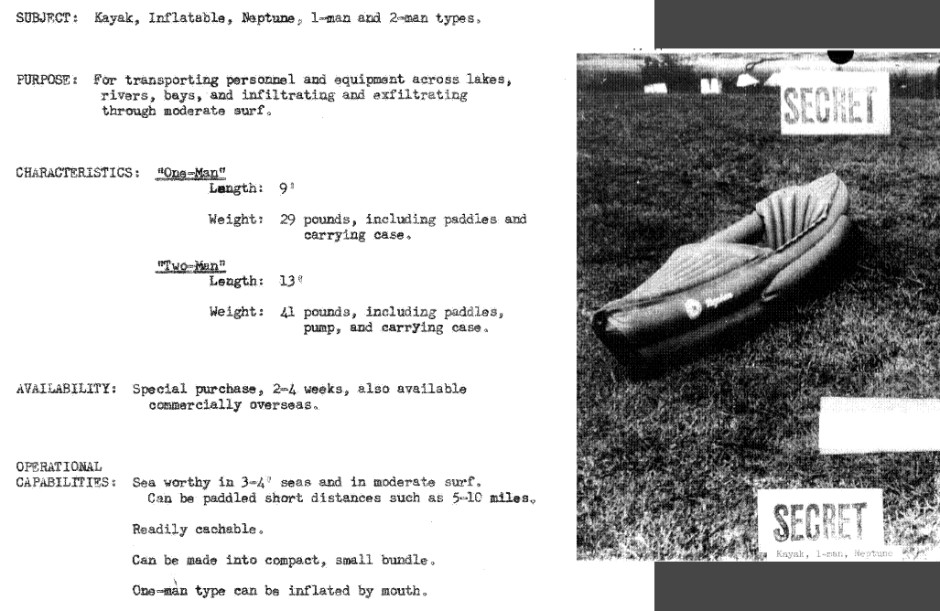
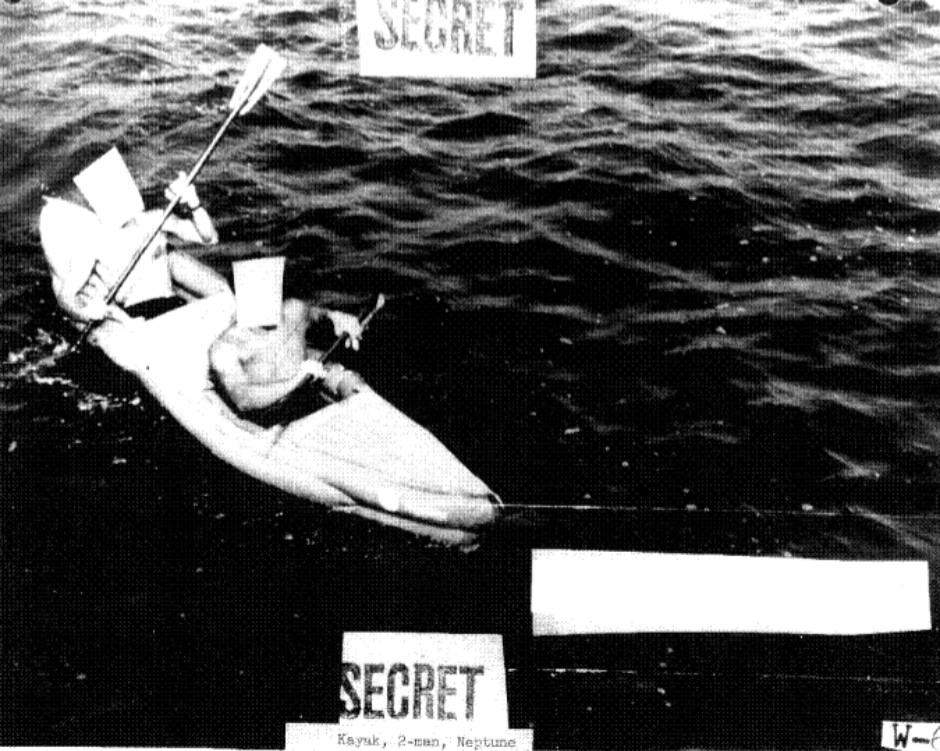
Klepper folding kayak. Klepper are one of the oldest names in western folding kayaks having produced them since the early 1900s. By 1958 this was the prototypical military folding kayak. OSS (Office of Strategic Services, forerunner of CIA) learned to use kayaks from the British in World War Two, and used them on some missions. The British still term them canoes in military/naval parlance.
Although the OSS developed several types which were generally quite innovative, during the war the best designs during the war had been British and Australian. In the 1950s however British and Australian attempts build canoes to increasingly demanding standards actually resulted in a series of expensive failures, so German manufacturer Klepper was able to step back in with off-the-shelf kayaks. Soon after this booklet even the British adopted the Klepper, terming in the Canoe Mk.13.
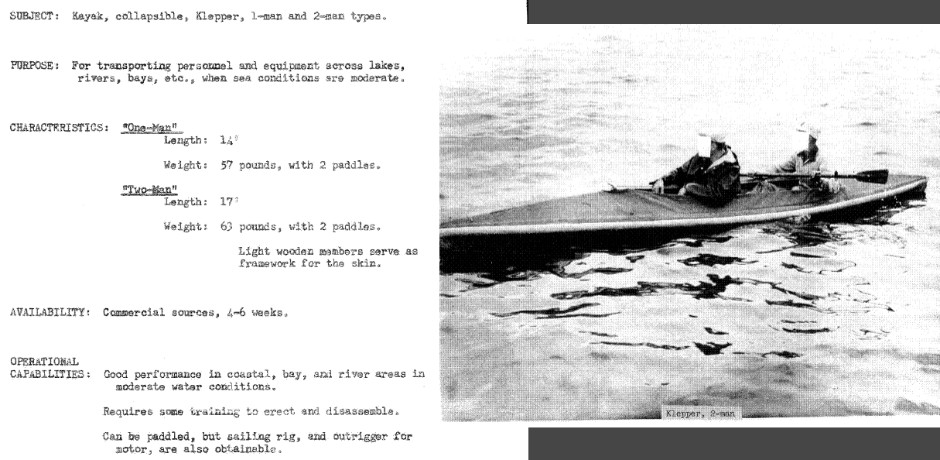
Paddleboards
Another type of equipment that OSS picked up from working with British Special Forces during World War Two, Paddleboards are one of the forgotten types of equipment used by special forces. The military use of paddleboards dates back to WW2 when a Canadian Naval officer, Lt-Commander Bruce Wright, RCNVR, conceived a specialist unit for reconnaissance and ship attack. Wright figured that a swimmer on a paddleboard could overcome magnetic, acoustic and net defenses and slip into an enemy harbor undetected. The swimmer could then plant limpet mines on enemy ships. In the darkest days of the War his Proposal was accepted and he was ordered to UK where he set up the Sea Reconnaissance Unit (SRU). This trained alongside the Army’s Special Boat Section (SBS) and the deceptively named Royal Marine Boom Patrol Detachment (RMBPD), both of which mainly operated canoes.
The low-profile paddleboards were seen as an intermediate level of stealth between a canoe and swimming. They provided better range than swimming alone, but were colder than canoes and only carried one man.
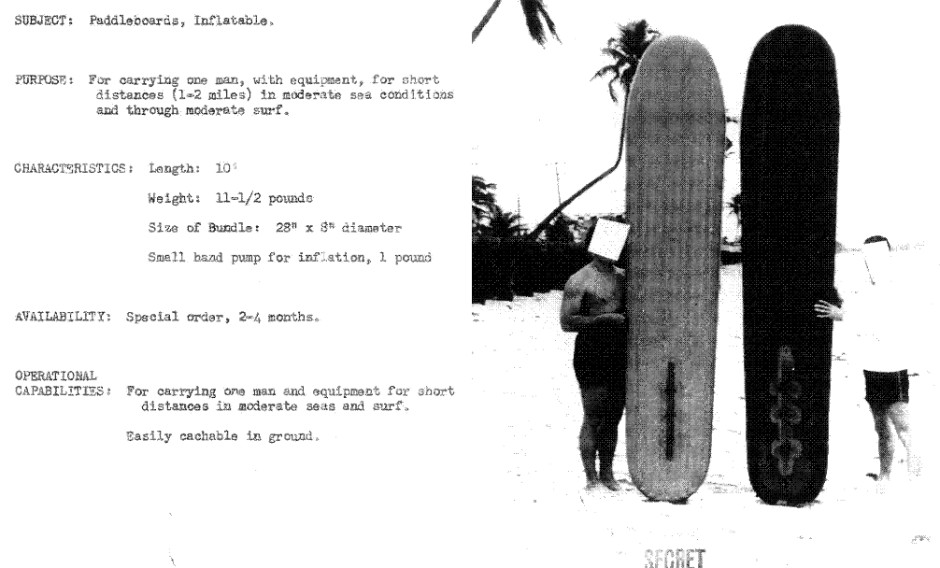
It is interesting that by 1958 the CIA Water-Air Division only listed an inflatable type. Wartime paddleboards and those in use by British Special Forces (notably the Royal Marine’s SBS) and Canadian Clearance Divers where rigid. Below is a wartime photo of OSS Maritime Unit training with paddleboards:
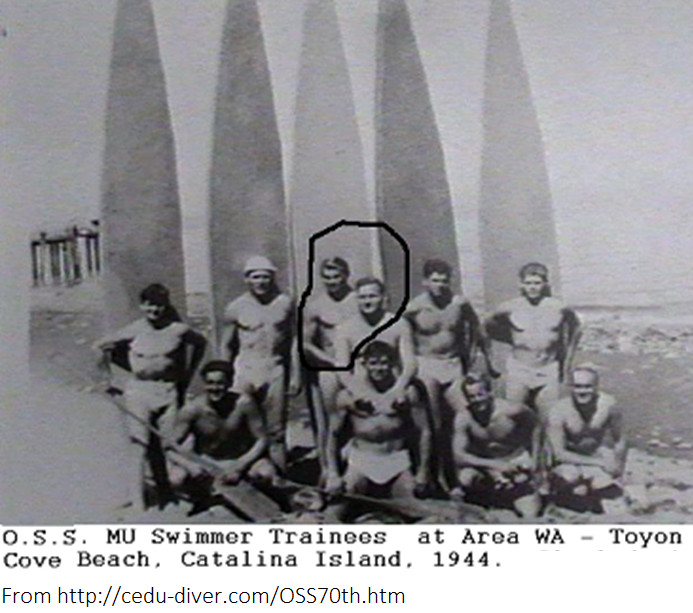
Submersible SKIFF
Credit for most of the research on the topic of the fascinating craft goes to Jim Anderson, LCDR USNR (ret) and Dirk A.D. Smith. Read more HERE
Once the Korean War started the CIA was active in Korea running agents and saboteurs, many of whom needed to be inserted and recovered amphibiously. To achieve this, the CIA worked closely with the various naval units and operated from the US Navy’s APDs and even USS Perch. Having never fully adopted canoes during WW2, the basic method of landing agents employed inflatable rubber boats. The obvious problem was that in order to do this, the parent boat or submarine had to come quite close in to shore where it was exposed to detection by radar. As in the previous war, the CIA looked to more covert methods of insertion which led to them to take another look at submersibles. It is therefore no surprise that the CIA dusted off the wartime OSS project documents, and rekindled the GIMIK submersible agent infiltration boat that had come so close to seeing action during the final months of WW2. The direct connection between the rebirth of GIMIK and the Korean War remains speculative although it is an easy conclusion to draw when you connect the dots.
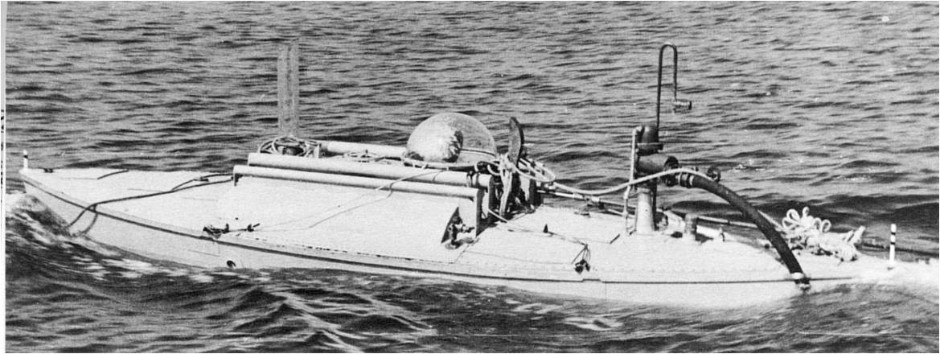
One curiosity is that the angled fish-tank canopy over the pilot’s station was replaced by a Perspex dome which may have been influenced by captured German sneak craft examined by OSS at the end of the war.
The SKIFF was ready in mid-1953 and was put through tests in September. The obvious problem was that the Korean War had just ended and an uneasy armistice now held on the Korean Peninsula. For a time the SKIFF was a boat without a war. In 1959 one of the two SKIFFs was deployed to Saipan for operations in the Far East (the target remains classified), but for whatever reason the mission did not go ahead and the boat was disposed of locally.
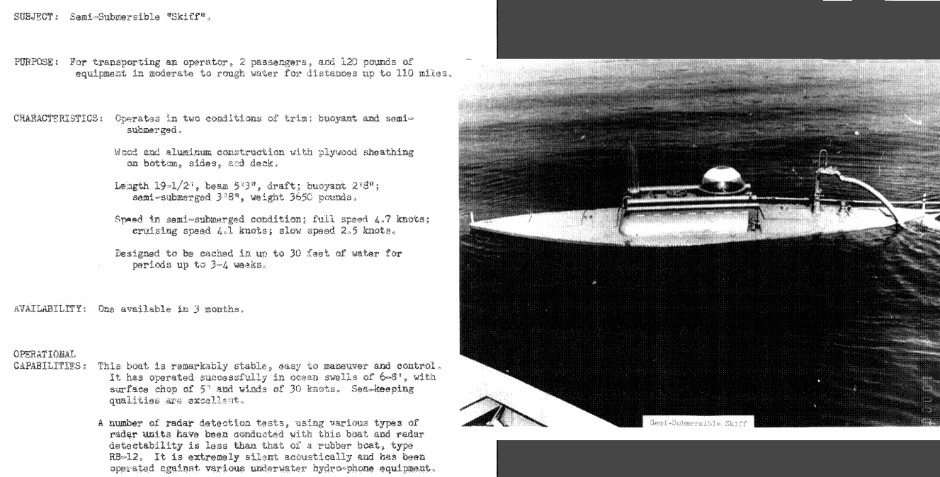
Hydrofoils
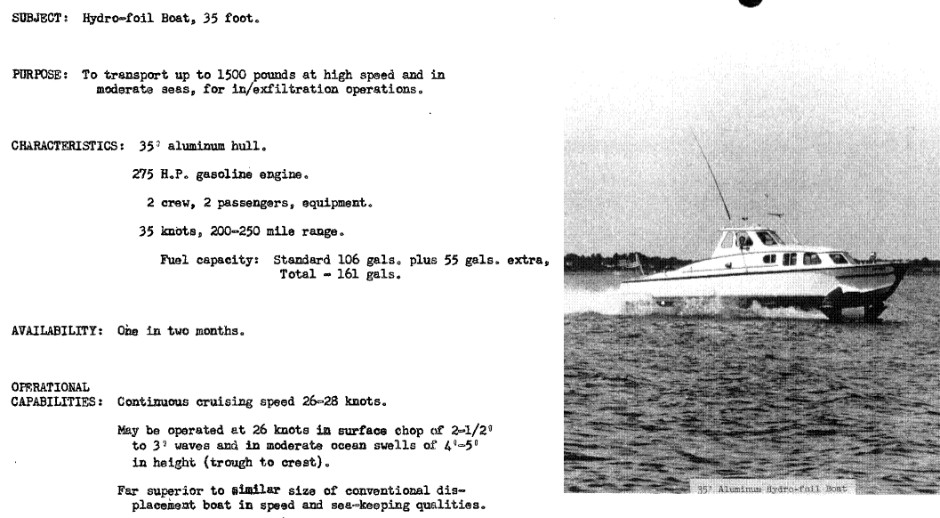
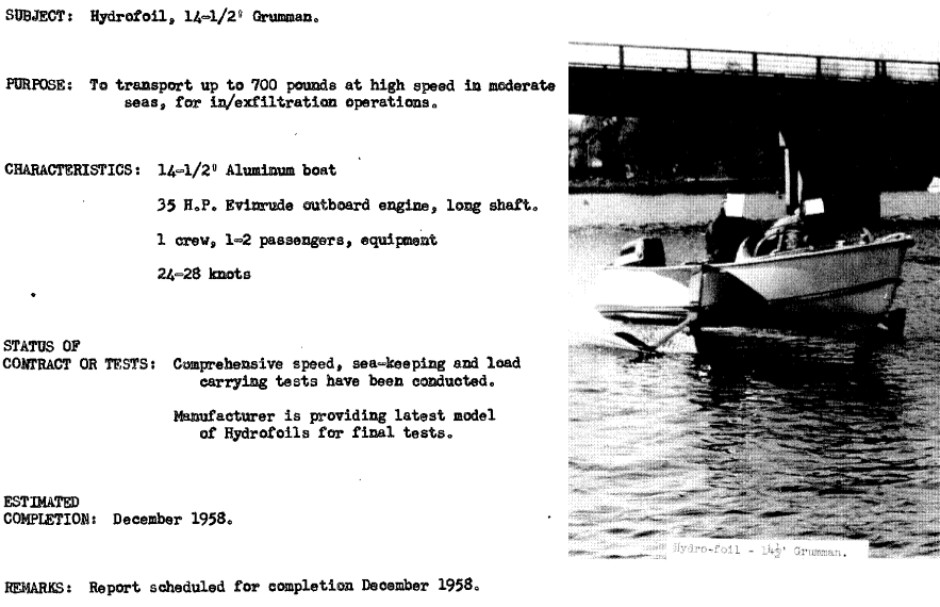
Inflatable boats
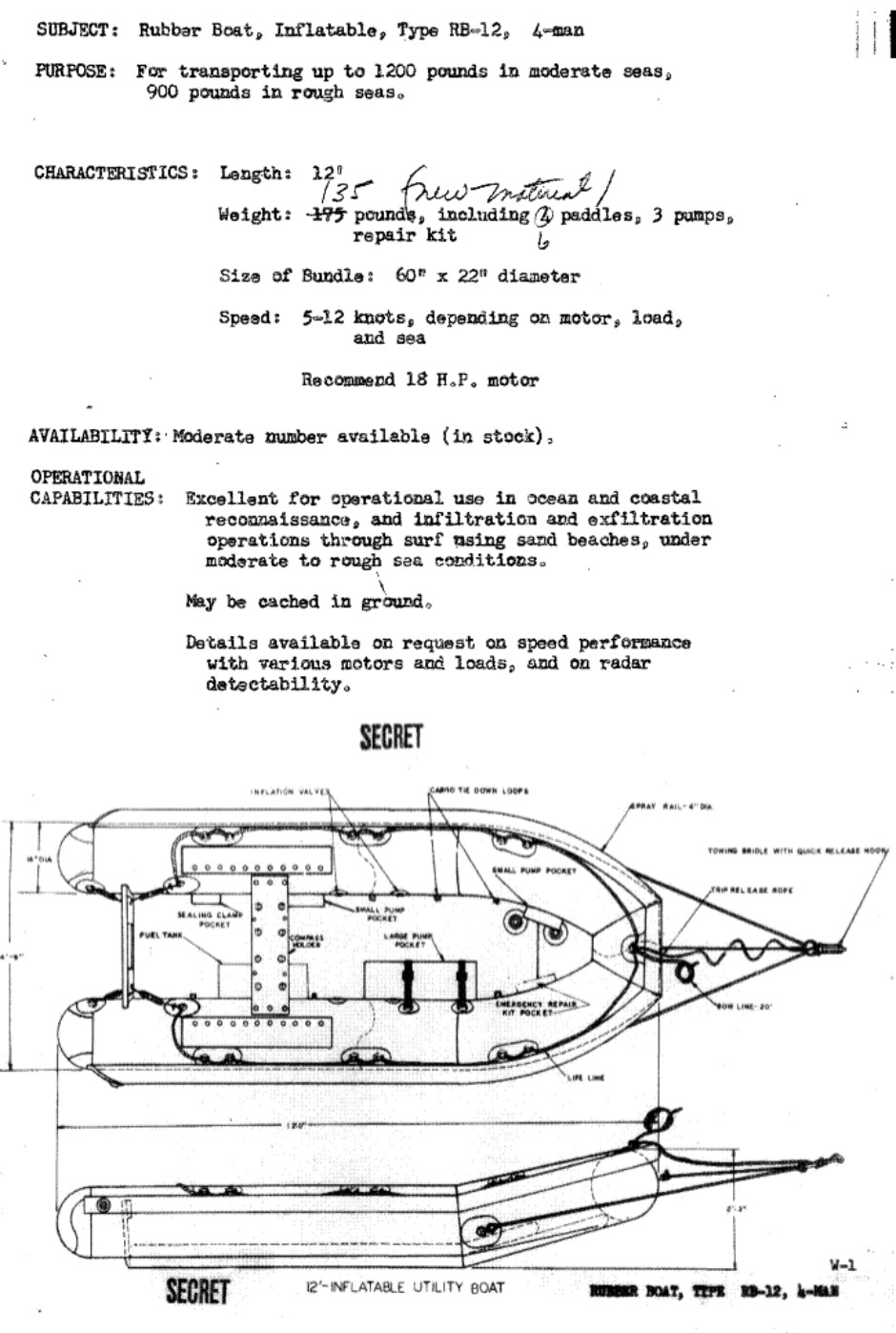
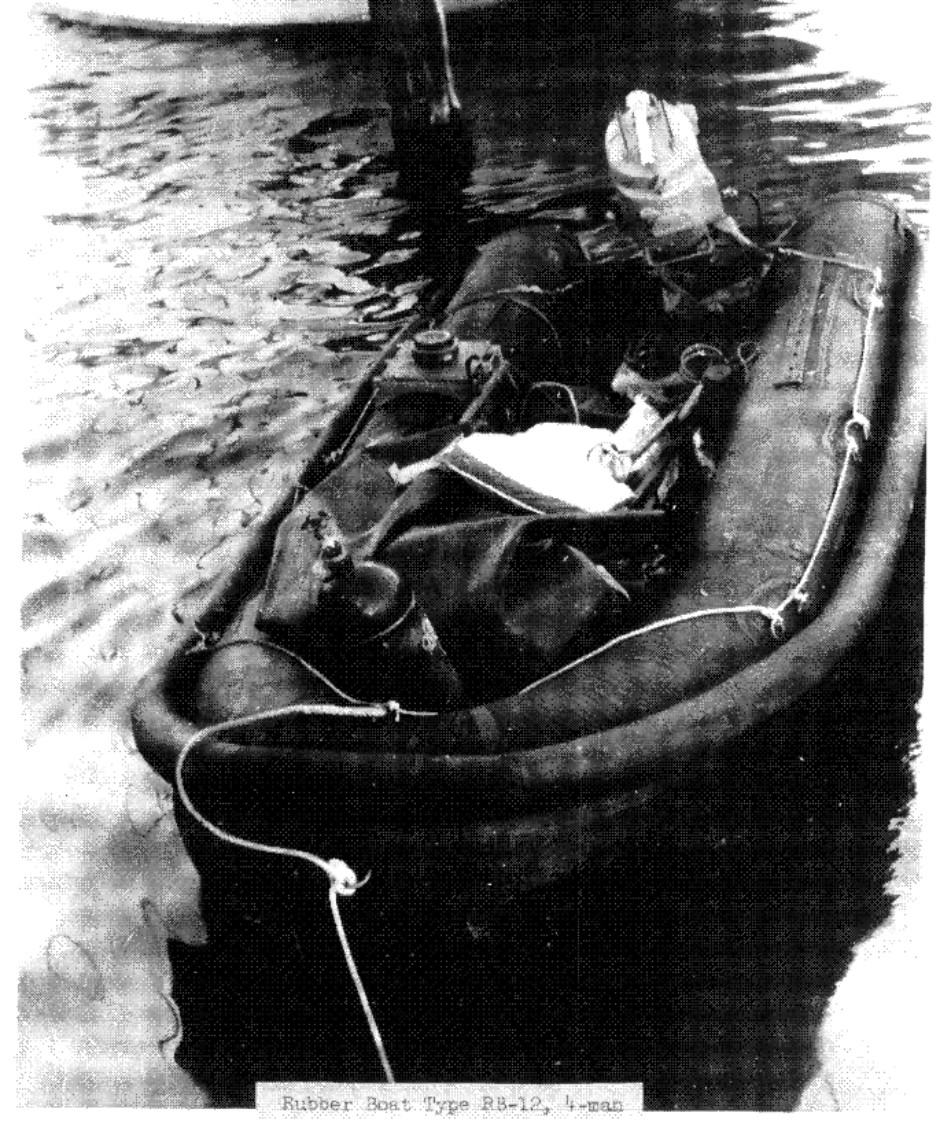
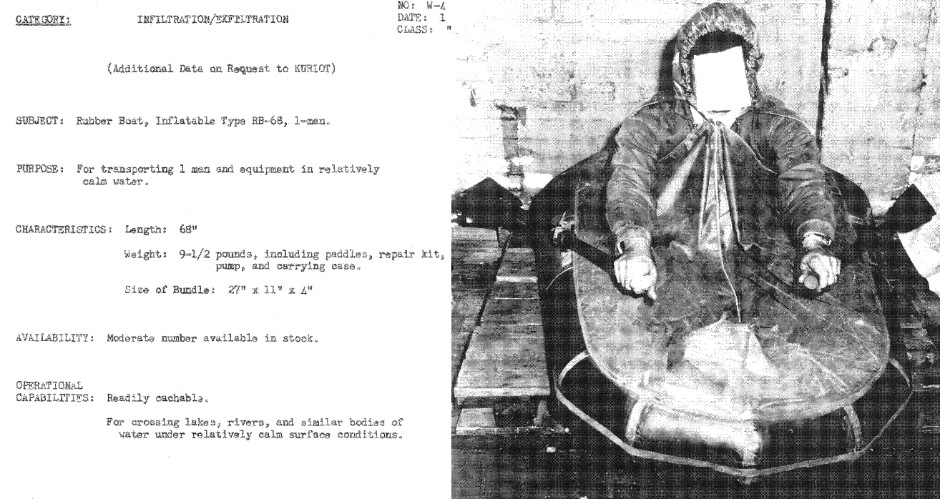
Underwater Breathing Apparatus
Aqualung open-circuit air breathing apparatus. The French developed open-circuit air breathing apparatus had safety advantages over the wartime close-circuit pure oxygen rebreathers. For this reason it was widely adopted by the US Navy’s Underwater Demolition Teams who worked closely with the CIA (having absorbed some of OSS Maritime Unit during the final months of World War Two). It does however leave a trail of bubbles, marking the diver on the surface so it would not be used in enemy harbors.
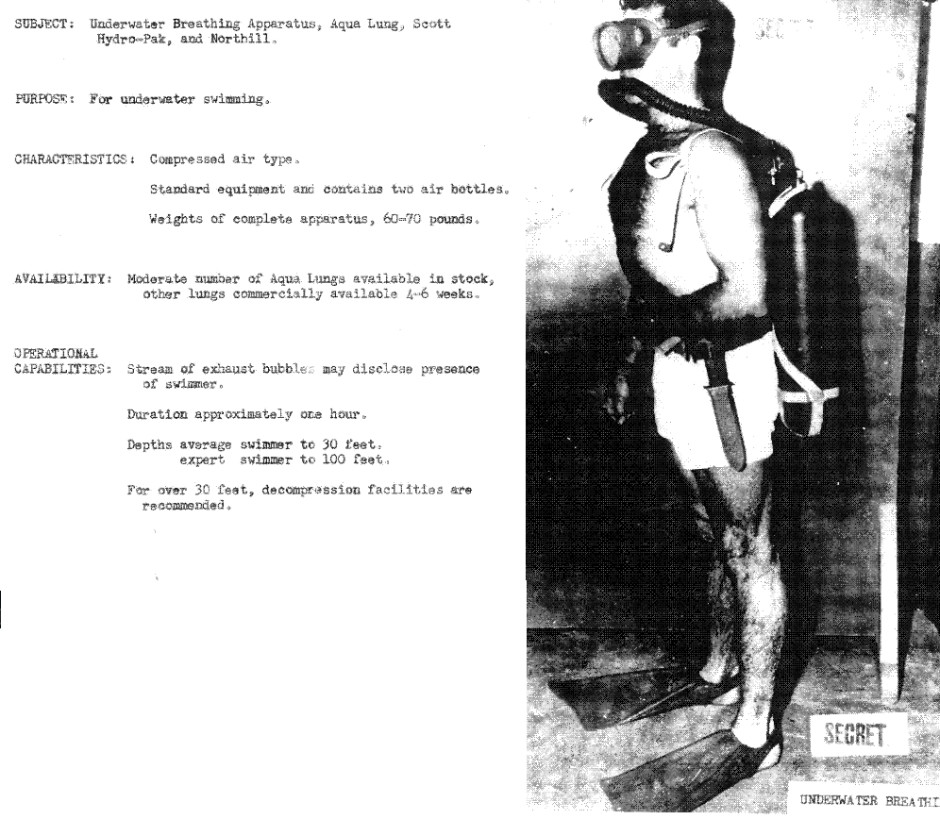
Rebreathers. These used pure oxygen in a closed-cycle and were appropriate for sabotage missions in enemy harbors. The US also had manufacturers so it is interesting that the CIA preferred these imported types.

Underwater Telephones
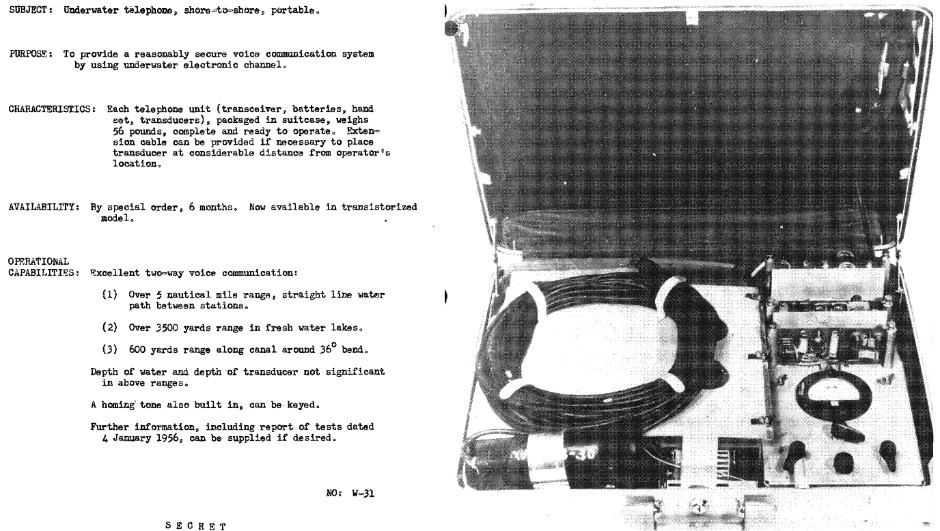
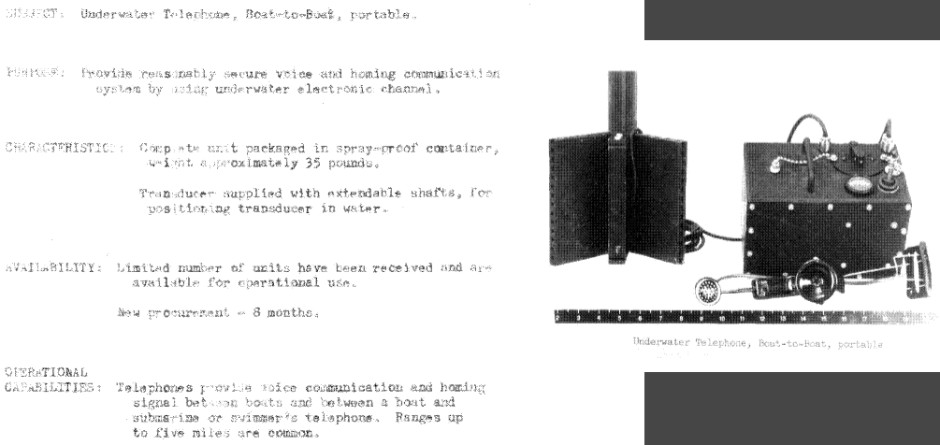
Aircraft
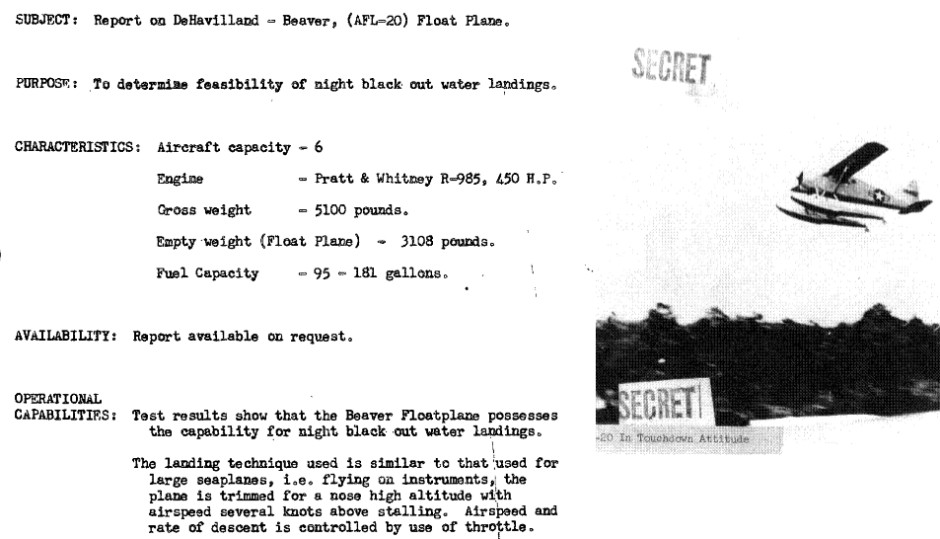
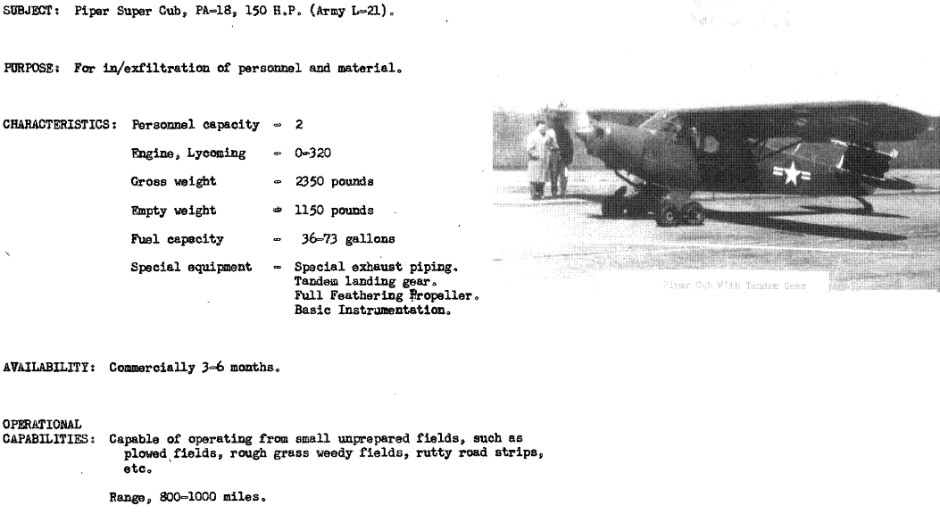
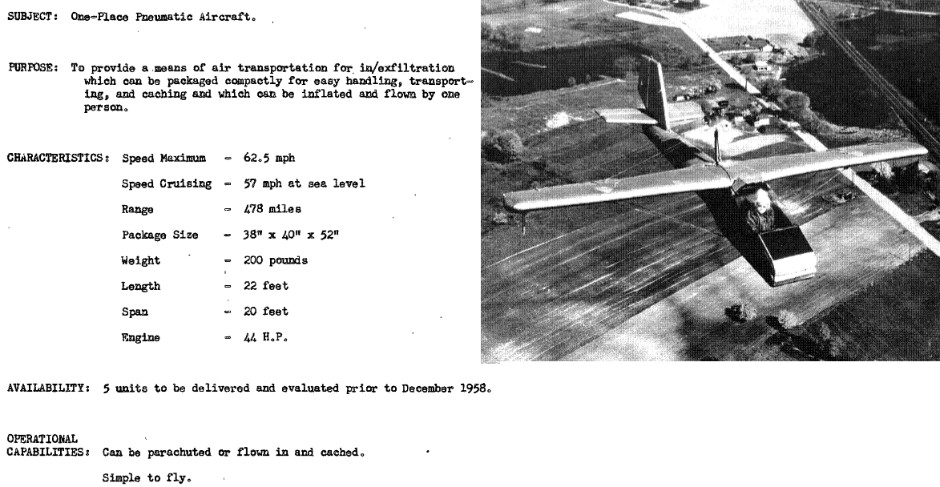
Note that the inflatable aircraft is the Goodyear Inflatoplane: https://en.wikipedia.org/wiki/Goodyear_Inflatoplane
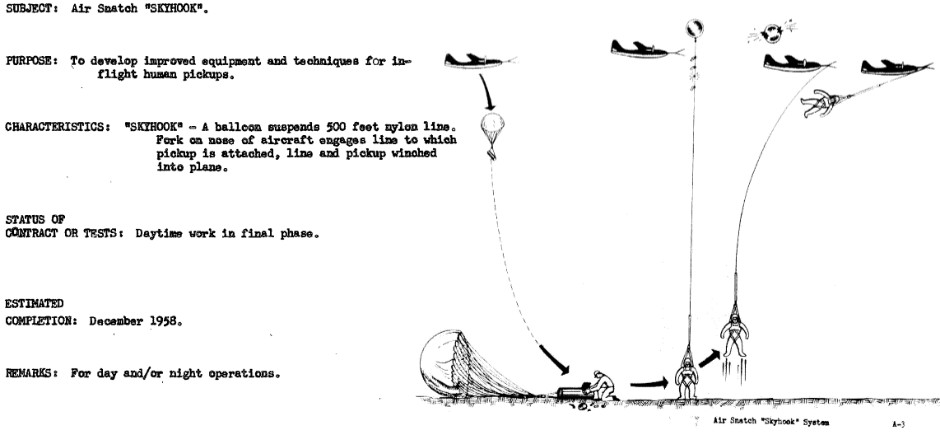
Related Articles

 SDV Mk.9 SEAL Delivery Vehicle
SDV Mk.9 SEAL Delivery Vehicle

 DGSE's SDVs
DGSE's SDVs


 Lockheed S301i, S351 and S302 Dry Combat Submersibles
Lockheed S301i, S351 and S302 Dry Combat Submersibles


 USN Navy SEAL's UOES3 (Button 5.60) Dry Combat Submersible (DCS)
USN Navy SEAL's UOES3 (Button 5.60) Dry Combat Submersible (DCS)

 SWSC (Shallow Water Combat Submersible) US Navy SEALs next gen' SDV
SWSC (Shallow Water Combat Submersible) US Navy SEALs next gen' SDV

 Naval Spetsnaz in Hybrid Warfare (Russian SDVs and DPVs)
Naval Spetsnaz in Hybrid Warfare (Russian SDVs and DPVs)
 Sleeping Beauty (Motorised Submersible Canoe) of WW2
Sleeping Beauty (Motorised Submersible Canoe) of WW2

 CSS-1 collapsible SDV
CSS-1 collapsible SDV


 CCH (Combat Craft Heavy) SEALION and Alligator Semi-Submersible Boats
CCH (Combat Craft Heavy) SEALION and Alligator Semi-Submersible Boats

